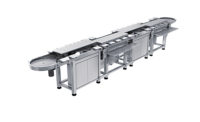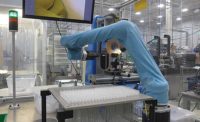Small Robots Play a Big Role in Automation
Compact tabletop machines are becoming more popular with manufacturers












In basketball, the most flexible player is often the smallest person on the team. Small robots play a similar role in manufacturing.
Tabletop machines in articulated, Cartesian and SCARA formats perform many of the same functions as their larger cousins that traditionally occupy large footprints in factories.
Small robots are typically classified based on their reach and payload, such as a reach of 500 millimeters or less and a payload capacity under 3 kilograms. Large and small manufacturers rely on the machines to mass-produce things such as automotive parts, electronics, medical devices, optics and watches.
They’re used to assemble automotive electronic control units, cell phones, printed circuit boards (PCBs) and syringes. Mini robots are also used to test and inspect small parts, such as buttons and screens.
A variety of benchtop robots are available today to automate tasks in lower volume operations. These compact machines can be used for kitting, machine tending, parts feeding, and test and inspection tasks. Assembly applications include adhesive dispensing, polishing, screwdriving and soldering.
Small robots cost much less than larger robots, are easy to set up and require less programming. Many machines are easily portable; they can be unboxed, plugged in and ready to go in less than 1 hour.
Although most tabletop robots are typically attached to a desktop or a workbench, they can be mounted in any orientation on any surface, including ceilings or walls.
Numerous Advantages
Tabletop robots provide big performance in a small package. They offer a cost-effective way to handle and assemble small parts, especially when space is scarce.
“The biggest advantage of using small robots is the size of the footprint,” says Dean Elkins, segment leader for material handling at the Motoman division of Yaskawa America Inc. “If you can make a mini fabrication cell in a small amount of space, it’s a bonus in terms of return on investment and cost savings.
“One of the biggest myths about small robots is that they’re nonindustrial toys that aren’t very flexible,” notes Elkins. “But, that’s not true. Tabletop robots can be very robust. In fact, we build all of our MotoMini machines with the same life expectancy as all of our bigger machines.”
“Desktop robots are ideal for precision assembly of small components, such as installing and tightening tiny screws on PCBs,” adds John Iskra, robotic systems and automation sales manager at ASG, Div. of Jergens Inc., which offers the AX-03 and AX-05 Cartesian models.
“Tabletop robots have a small footprint, which enables manufacturers to utilize as much space as possible,” notes Iskra. “A lot of plants have limited space these days, because they’re always expanding their product lines.”
“A small footprint enables manufacturers to use smaller assembly cells where you can look at some batch processes, but still have the option to do things in line,” says Phil Cohen, general sales manager at Janome Industrial Equipment USA Inc.
“It gives engineers more modular flexibility in how they plan their assembly lines,” claims Cohen. “Also, smaller robots don’t require the same type of safety guarding that you need with big six-axis machines.
“Our machines live right next to operators,” Cohen points out. “Because we use stepper motors, it’s a ‘pinch not sever’ type of situation, so the risk for potential injury is much lower.”
Janome’s popular JR3000 series was launched three years ago. The Cartesian robot is used for applications such as depaneling PCB boards, dispensing adhesive and screwdriving. It’s commonly used for traditional one-part syringe dispensing, meter-mix dispensing, jetting and conformal coating.
“One of the newest applications is automated optical inspection,” says Cohen. “Manufacturers can use the JR3000 series robot to dispense adhesive, then look for defects such as color change, missing components or solder joint quality.”
In addition to size, another advantage of small robots is portability. They are interchangeable and can easily be picked up and moved around. Some multinational manufacturers even ship their small robots to different factories around the world as production needs fluctuate.
“Because of its small size, robots such as our Meca500 can be mounted anywhere in a workcell,” explains Stan Gleizer, sales and technical support manager at Mecademic Inc. “If necessary, manufacturers can put many robots in a small, confined space. We have quite a few customers that are using multiple machines.
“We’re trying to promote our robot as a component that’s used in conjunction with larger machines,” says Gleizer. “Some of our customers use it as a linear slide or positioner. Pick-and-place is one of the most popular applications that our robots are used for, especially in the medical device industry.”
“Bench-mounted, collaborative robots enable engineers to take an incremental approach to automation,” adds Joe Campbell, senior manager for strategic marketing and application development at Universal Robots, which offers a model called the UR3 that features a 3-kilogram payload. The UR3 boasts the same 0.1-millimeter repeatability as the company’s larger UR5 and UR10 robots.
“With the UR3, we can now fit a six-axis robot into more assembly lines where erecting large safety enclosures would not be feasible,” says Campbell. “Because of its compact form and easy programming, it’s easy to switch between tasks to meet agile manufacturing needs, making total cost of ownership low and payback period fast.
“You can drop a robot in the middle of a manual assembly line to do one task,” explains Campbell. “That really changes the motivation for automation in many places.
“Tabletop robots are also easily redeployable, which is a huge advantage,” claims Campbell. “They can be mounted onto mobile carts that get wheeled from machine to machine or process to process as they’re needed. That is changing how automation is viewed in small contract assembly shops that focus on high-mix, low-volume applications.”
Traditionally, a plant with fewer than 50 employees has not been a good candidate for automation. But, old barriers of expense and complexity are now breaking down.
“We’re seeing significant interest from small- and medium-sized manufacturers, which often don’t have in-house automation departments,” says Campbell. “In many cases, our robots are being deployed by non-engineers and non-automation specialists.
“However, there’s a misperception that everything has to go fast and that cycle time is everything,” Campbell points out. “In reality, there are a lot of projects that don’t require it. We encourage our customers to look for projects that offer fairly straightforward incremental opportunities for automation.”
It’s a Small World
Engineers can choose from a variety of tabletop robots. Small machines currently available include the ABB IRB 1200, the Denso Cobotta, the Fanuc SR-3iA, the Fisnar F4000 Advance Series, the Kuka KR 3 Agilus, the Nachi MZ01 and the Nordson EFD E Series.
One of the newest mini robots is the Meca500 from Canadian startup Mecademic. The benchtop unit is 12 inches tall, with a base the size of the palm of a hand. A compact controller is embedded in the base of the machine.
The six-axis robot weighs less than 5 kilograms and has a payload capacity of 0.5 kilogram. Mecademic claims that it has a repeatability of 0.005 millimeter and a maximum reach of 330 millimeters.
“Anything that meets the payload requirement can be mounted to the end of the robot, including Fisnar dispensing equipment and Atlas Copco screwdrivers,” says Gleizer. “We also plan to launch a tabletop four-axis SCARA robot this summer. It will use the same base as the Meca500, but will be made for high-speed assembly applications.”
Another relatively new entrant in the tabletop robotics market is Koganei. The Cell Master DTRB Series is a three-axis Cartesian robot that boats an A4-size footprint. It weighs 12 pounds and is accurate to 0.02-millimeter.
“A4 is the size of a standard 8.5-by-11-inch sheet of paper,” notes William Miller, national marketing manager at Koganei International America Inc. “In addition to being compact and lightweight, our machine is quiet. That’s important in clean rooms and other facilities where small electronic and medical device components are assembled.”
Yaskawa’s MotoMini has been available for less than two years, but has proven to be popular with both large and small manufacturer. It weighs 7 kilograms and can handle a 0.5-kilogram payload. The small machine features a 350-millimeter horizontal reach and 0.02-millimeter repeatability.
“Because the MotoMini offers six degrees of freedom, it’s a flexible robot for small-part assembly,” says Elkins. “In contrast, a traditional SCARA robot offers only four degrees of movement. When you add two extra degrees of freedom, it opens up a whole realm of flexibility. For instance, the work envelope doesn’t have to be as linear.
“The MotoMini is 20 percent faster than comparable small robots, which reduces cycle time and boosts productivity,” claims Elkins. “A variety of mounting options, including surface, wall and ceiling, accommodate high-density factory layouts.”
Typical applications include loading small machines, such as presses. The MotoMini is also used for testing medical devices and parts kitting applications.
“We’re just starting to scratch the surface in terms of the application of tabletop robots,” says Elkins. “I think there’s a lot more potential out there.”
Looking for a reprint of this article?
From high-res PDFs to custom plaques, order your copy today!












